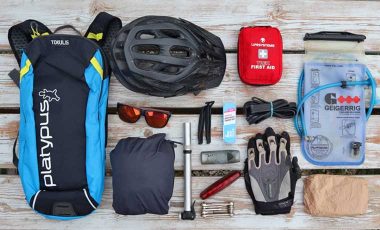If you’re new to hitting the trail on two wheels, then you’re going to need to get kitted out and geared up. Aside from a bike and helmet, there are a few mountain biking essentials that you’ll also need to have with you every time you head out.
From bike repair gear and personal safety gear, to clothing and food, our guide to mountain biking essentials takes you through all the basic items needed for a day on trail. You’ll also find a handy checklist at the bottom of the article which is an ideal resource to turn to when starting out.
- Essentials for mountain biking
- Essentials for mountain biking: tools and repair kit
- Essentials for mountain biking: clothing
- Other items to take mountain biking
- Mountain biking essentials list
Disclaimer: We use affiliate links and may receive a small commission on purchases.
Essential gear for mountain biking
The two most essential mountain biking items are a bike and helmet. You can’t do it without a bike, and you shouldn’t do it without a helmet. But to enable you to carry all the other items you’ll also need a backpack.

Bike
Mountain bikes come in a whole range of specs, budgets, brands and types. Beginner mountain bikers are best off with a hardtail bike with front suspension and plenty of gears. The easier the ride, the more likely you are to love it and want to come back for more. That said, there’s no need to spend a fortune. There are some decent options out there for kids and beginners for around the $500-600 mark.

Helmet
Much like bikes, you can spend whatever you want on mountain biking helmets. But it’s important that you choose a helmet that fits well and feels comfortable, not to mention provides the right amount of protection. New MIPS (Multi-directional Impact Protection System) technology reduces rotational motion to the brain on impact and is a good option for extra protection. If in doubt, look for safety certifications: EN1078 – European Standard or ASTM F1952 – American Standard.
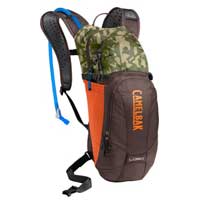
Backpack
Ideally, mountain biking backpacks should be compatible with a water bladder to enable easy sipping on the go. They should also fit snugly with a chest and waist strap to prevent them from moving around too much. Lots of internal pockets are a plus, to organise your repair tools, food and clothing. And they shouldn’t be too big. 5-15 litre capacity should be sufficient for most riders.
Essentials for mountain biking: tools and repair kit
Though it may be tempting to go for short rides without repair tools, you’re almost guaranteed to need them when you don’t take them! Mountain bikes are put through hell, and rarely complain. But when the going gets too tough for them, you’re the only one who can get them back on track. So, as well as carrying the right tools, you’ll need to know how to use them. Practise some basic bike maintenance at home before you hit the trail. You’ll be thankful later on!
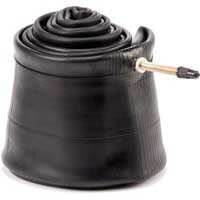
Spare inner tubes x2
Not all tyre inner tubes are the same. So be sure to get the correct ones for your bike. First up, you need to know which type of valve the wheel rim is compatible with: Schrader (shorter and fatter) or Presta (long and narrow. Look at the existing tubes on your bike to find out. Secondly, get the right size tube. Your bike tyres will have numbers, like this: “29×1.9”, printed on their sides. This indicates the circumference of the wheel (29 inches) and the width of the tyre (1.9 inches).
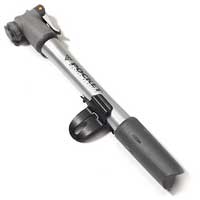
Mini pump
There’s no use carrying spare tyres and patch kits unless you also carry a bicycle pump. Opt for a high pressure pump that is compatible with the valve of your inner tubes. Ideally, it should be lightweight to carry and small enough to fit into your backpack. Alternatively, some mini tyre pumps can be mounted on the frame of bikes. Though this works fine when riding in dry conditions and on mellow terrain, it’s not a great option on muddy trails as the valves can get blocked.

Tyre levers
If you’ve ever tried removing a tyre without using levers then you’ll know that it’s almost impossible! Two or three levers is enough to pry off the tyre, enabling you to repair or replace an inner tube. They’re small and lightweight and should come with you on every ride.

Patch kit
In the unlikely, or unlucky, event that you’ve managed to puncture both your spare inner tubes in one outing, you’ll need to repair the damage on one of your tubes. Patch kits are so small and lightweight that one should probably live permanently at the bottom of your backpack. As with all bike repairs, it’s useful to practise patching a puncture at home.

Multi-tool
Trailside repairs aren’t, unfortunately, limited to punctures. An untold number of things can go wrong on a mountain bike, especially in challenging conditions. Queue the mighty multi-tool! From tightening your bottle cage and fixing a broken chain, to adjusting brake and gear cables, a good multi-tool should have you covered for most mishaps. Sling it in your pack with the rest of your repair kit and you’ll almost certainly need to use it.
Essentials for mountain biking: clothing
Clothing for mountain biking varies greatly, depending on the season and location. However, when and wherever you find yourself cruising the trails, there are a few clothing basics that you’ll need for comfort and protection.
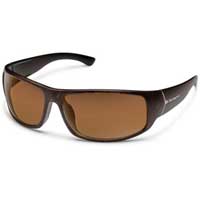
Eyewear
If you’re lucky enough to be biking in the sunshine then bust out your shades. So long as they fit comfortably underneath your helmet and provide ample UV protection, then any sporty sunglasses will do, especially for beginners. If the sun isn’t much of an issue (you’re on forest trails or in cloudy conditions), wearing cycling specific glasses with clear lenses is a good idea. These protect your eyes from bugs, as well as mud and debris from kicking up into them. Many advanced downhill riders wear goggles for protection.

Gloves
It’s a good idea to wear mountain biking gloves regardless of the temperature. Though they do provide warmth in cooler conditions, this isn’t their primary function. They’re designed to provide extra grip and padding, preventing blisters and calluses from forming. Cycling gloves also protect your knuckles and hands from grazes and cuts should you take a fall. Fingerless mountain bike gloves are available for hot conditions.
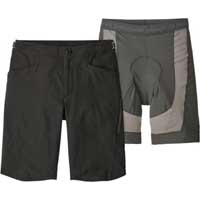
Padded shorts
Bike seats are inherently uncomfortable, and wearing padded shorts is highly recommended to help prevent saddle sores. That said, wearing tight lycra cycling shorts isn’t really the done thing in the mountain biking world. Instead, mountain bikers wear long and slightly baggy shorts that have padded seats built into them. They are also made of durable fabric that withstands life on the trail much better than lycra, providing protection from scrapes and falls. Alternatively, you can wear lycra cycling shorts or padded leggings underneath hard wearing shorts.
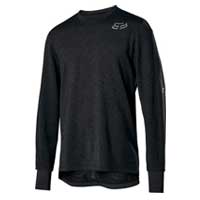
Jersey / base layer
Mountain biking jersey’s tend to be slightly baggy, with extra length at the back and made of synthetic fabric that is moisture wicking and breathable. However, any kind of technical base can also be worn. Merino shirts are good for long or multiple days on the trail as they don’t get too stinky. But synthetic fabrics deal better with excess moisture from sweating or the elements. Long or ¾ length sleeves are generally a good idea to protect your elbows from falls, and a long back prevents a gap appearing above your shorts.
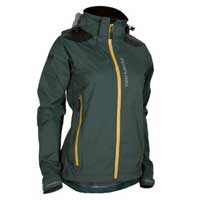
Jacket
Unless hot and dry weather is guaranteed, it’s always worth finding space in your backpack for a jacket. It should be waterproof, windproof and breathable (to limit sweat building up on the inside). Though any rain jacket will do the job, mountain biking specific jackets provide greater comfort and fit, offering ventilation through pit vents and extra length at the back. They also tend to be tougher than your regular rain jacket.
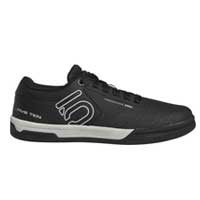
Shoes
Many advanced mountain bikers ride with specialist shoes that clip into the pedals on their bike. Beginner riders, however, don’t need to worry too much about mountain bike specific shoes. Flat soled shoes with good grip are ideal. And if riding in wet conditions then waterproof shoes will make life a little more comfortable.
Other essentials for mountain biking
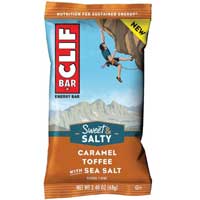
Snacks and food
Mountain biking is a physically (and mentally) demanding activity. Downhills can be as tough going as the gruelling uphills, so having the right fuel is important. Many riders use energy gels as they are lightweight and small to pack. However, making your own snacks – flapjack, energy balls, snack bars and trail mix, – is healthier and much more enjoyable. They also provide lots of energy and nutrition to keep you powering through.

Water
If you have a hydration compatible backpack then you’ll be able to carry a water bladder on your back. Depending on the length of your outing, you’ll need between one and three litres of water. Alternatively, you can fit a bottle cage on your bike frame to store a bottle or two. If you are riding in very hot conditions then adding electrolytes to your water is recommended. You can also make your own solution out of salt, honey and lemon.

First aid kit
Falls and crashes are an inevitable part of mountain biking. So you should never hit the trail without a first aid kit, even if only one rider in your group carries one. It doesn’t need to be huge. But having one can be the difference between getting an infected wound and ending your day badly or patching yourself up and riding on, relatively unharmed.
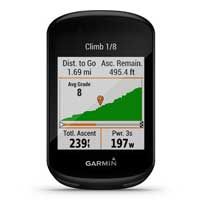
GPS and/or map and compass
If you’re riding at a trail centre then a GPS isn’t essential – though it is fun to track your route. A trail map will suffice. On cross country and backcountry rides, however, navigation tools are essential. You should know how to use them and have either backup batteries for your GPS or a backup map and compass.
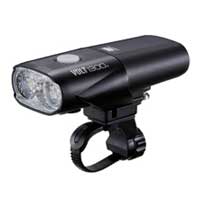
Lights or headlamp
Most mountain bikers don’t venture out after dark, especially beginners. That said, it’s always worth having a backup light or headlamp at the ready, just in case. Plans can change, mishaps can happen and it’s easy to find yourself still on the trail after dark. Either mount a powerful bike light on the front of your bike, or pack a bright headlamp in your pack.
Mountain biking essentials list
Having a mountain biking essentials packing list may seem overly organised, especially for experienced riders who learn, over the years, exactly what they do and don’t need on the trail. Beginner bikers, however, can benefit from a little guidance to ensure they are as safe, comfortable and prepared as possible.


